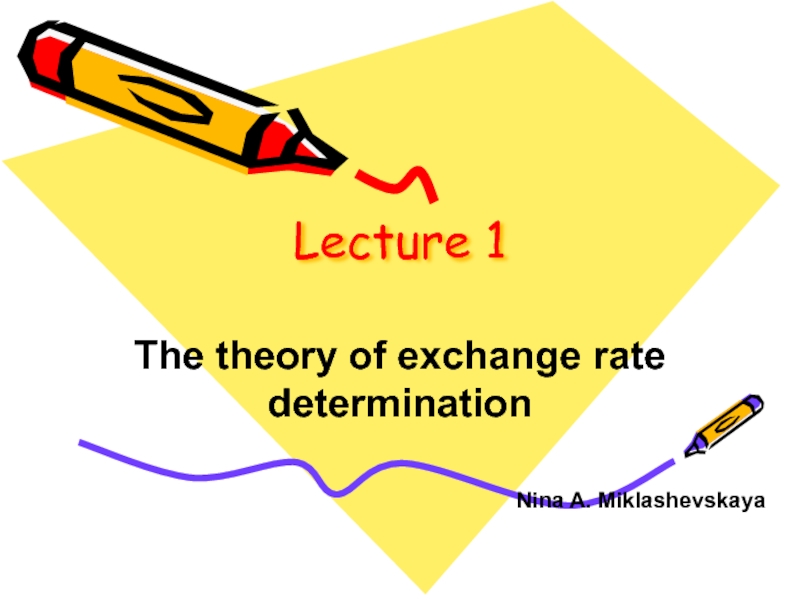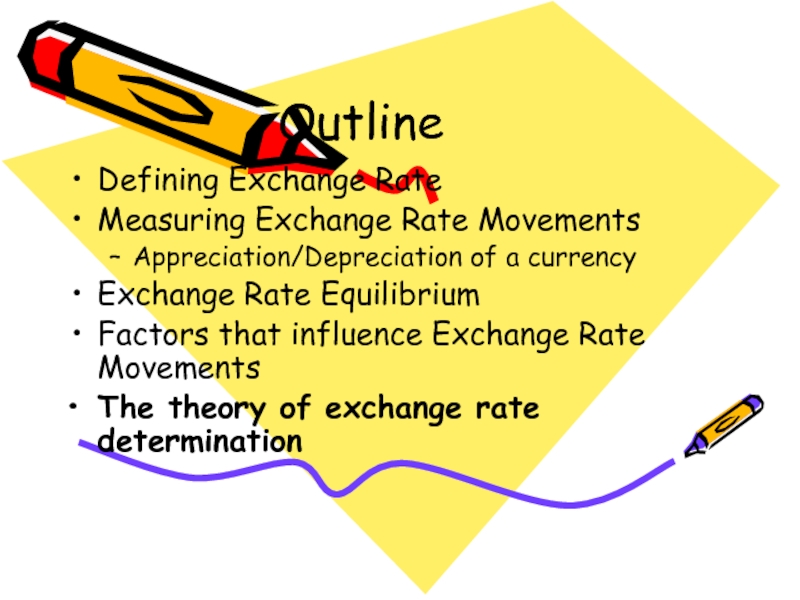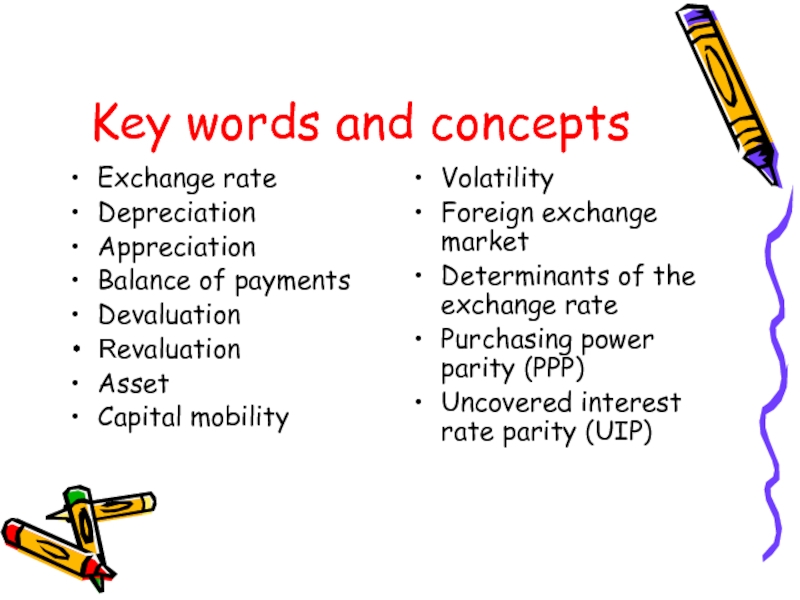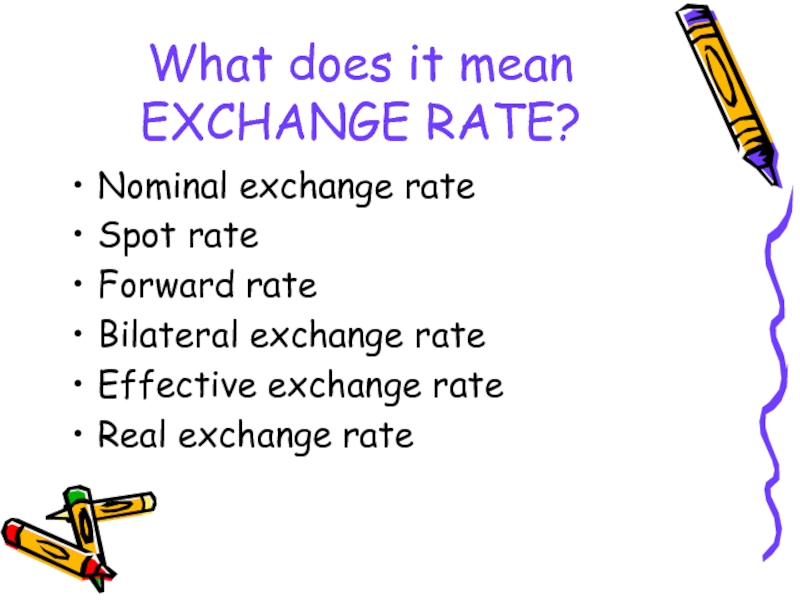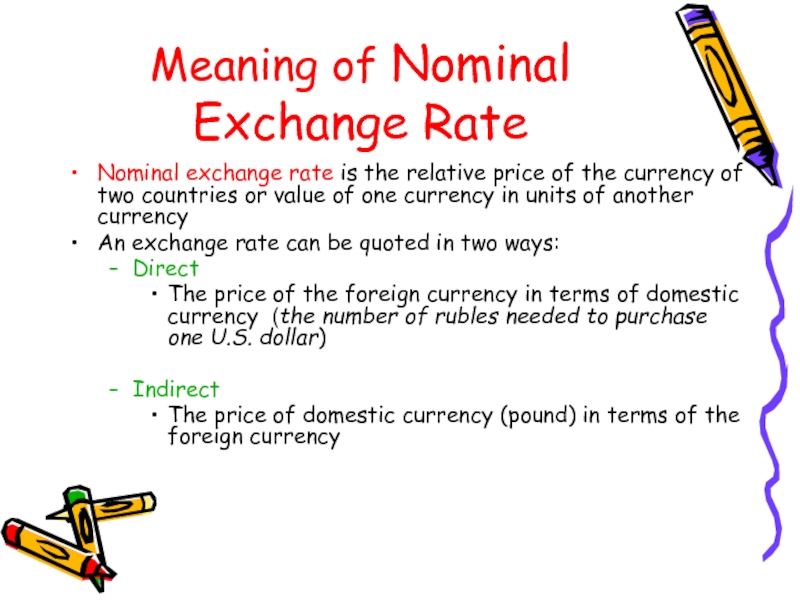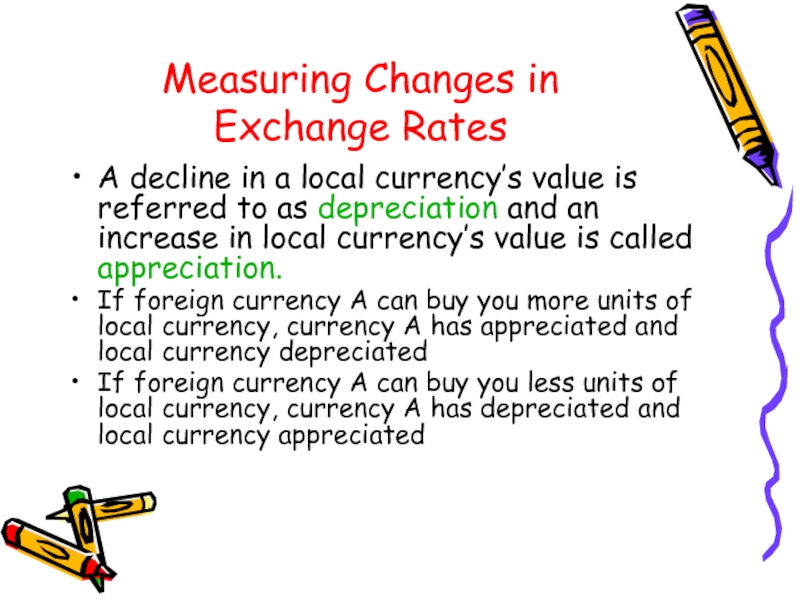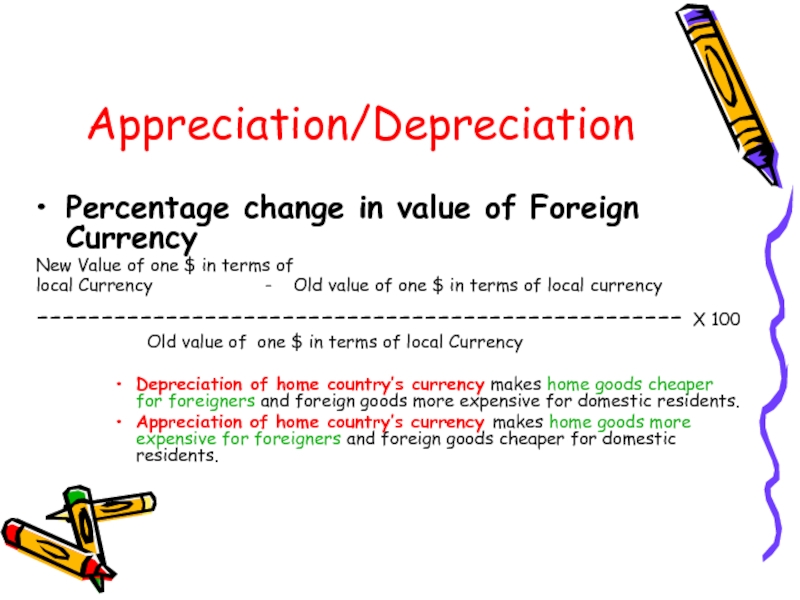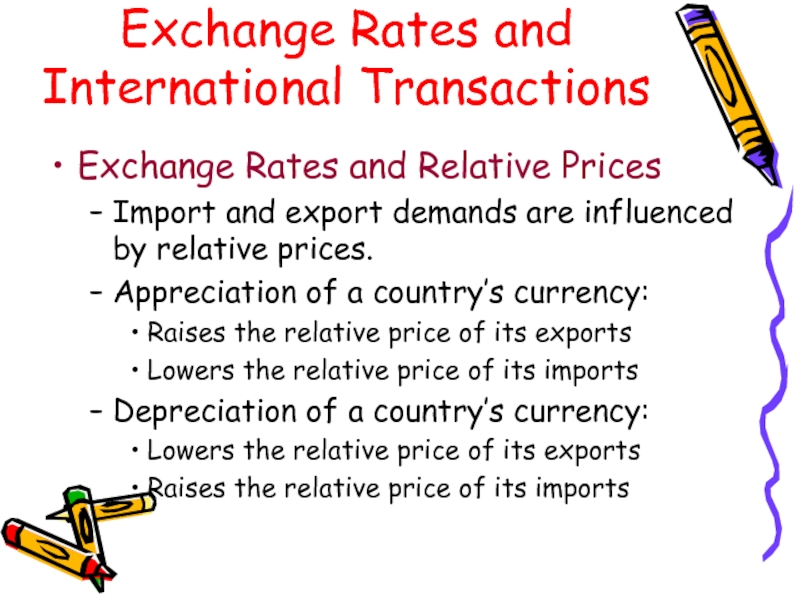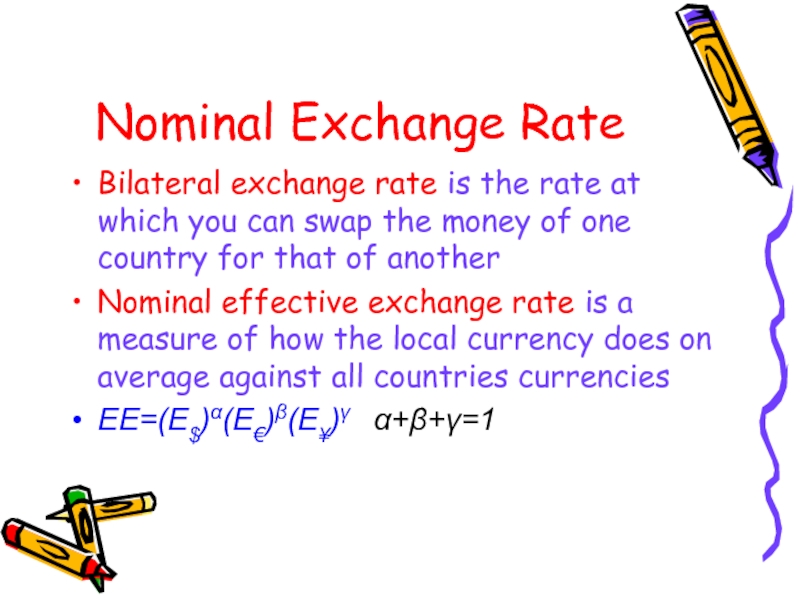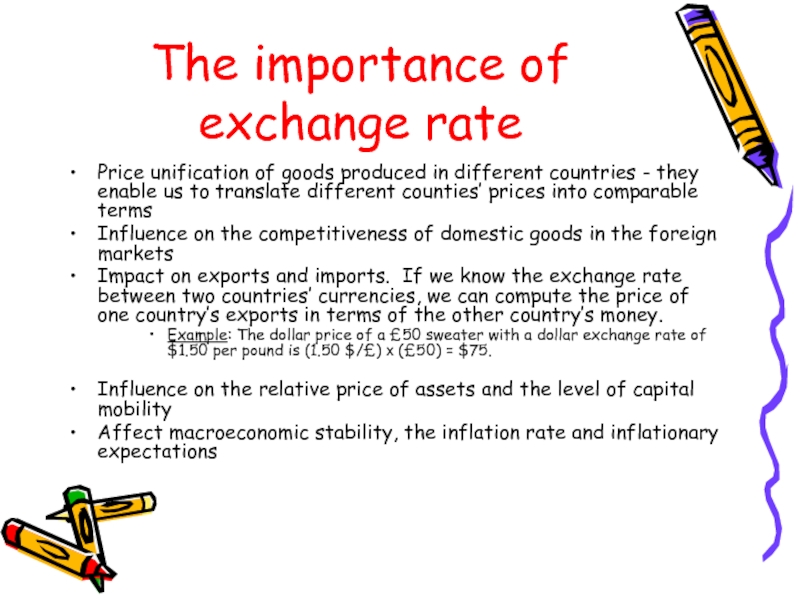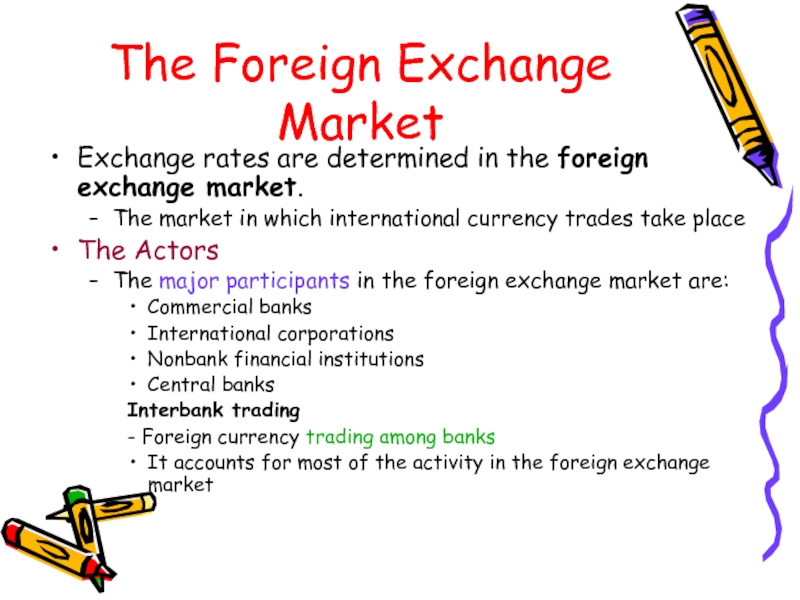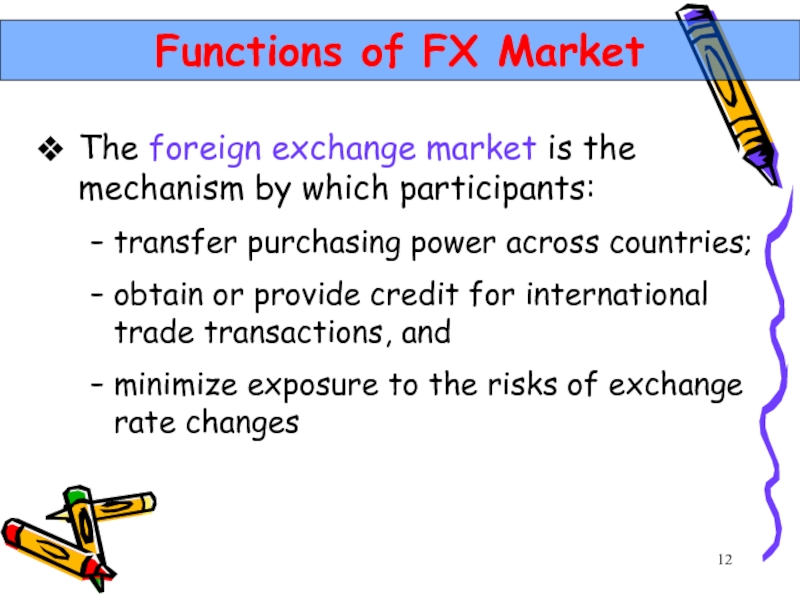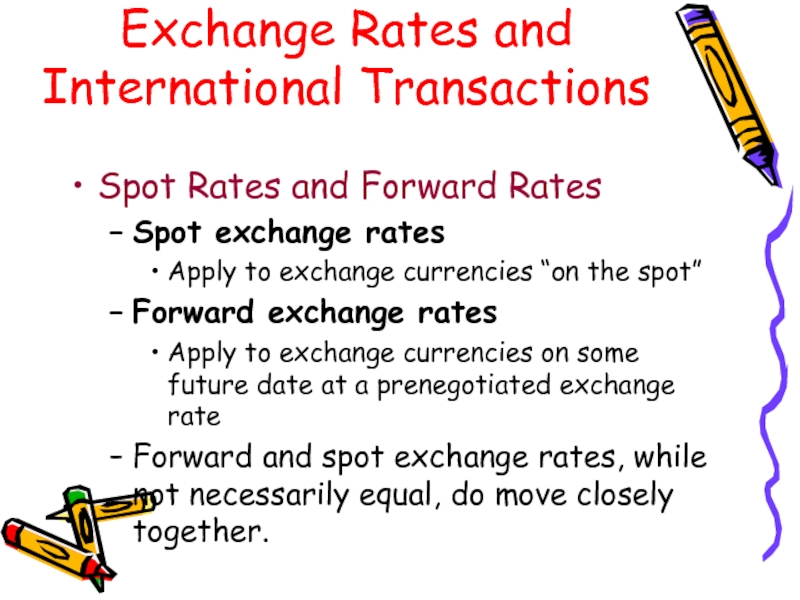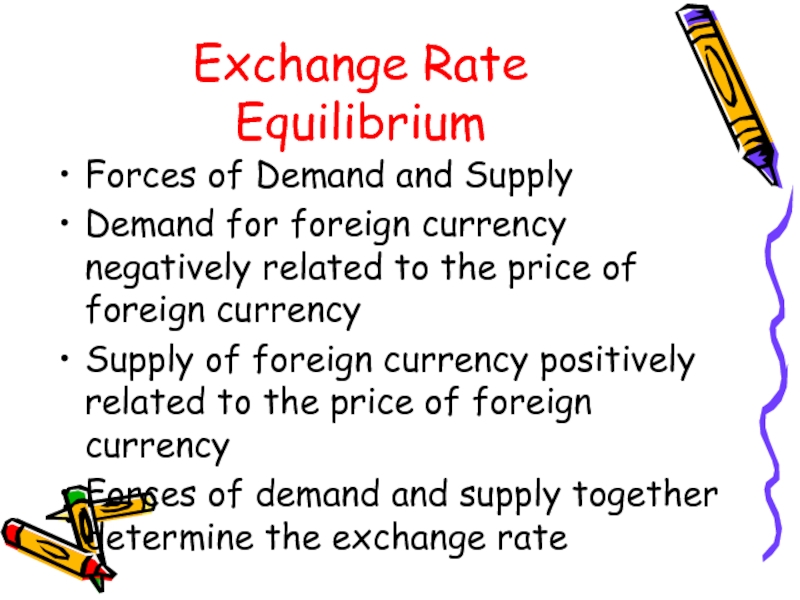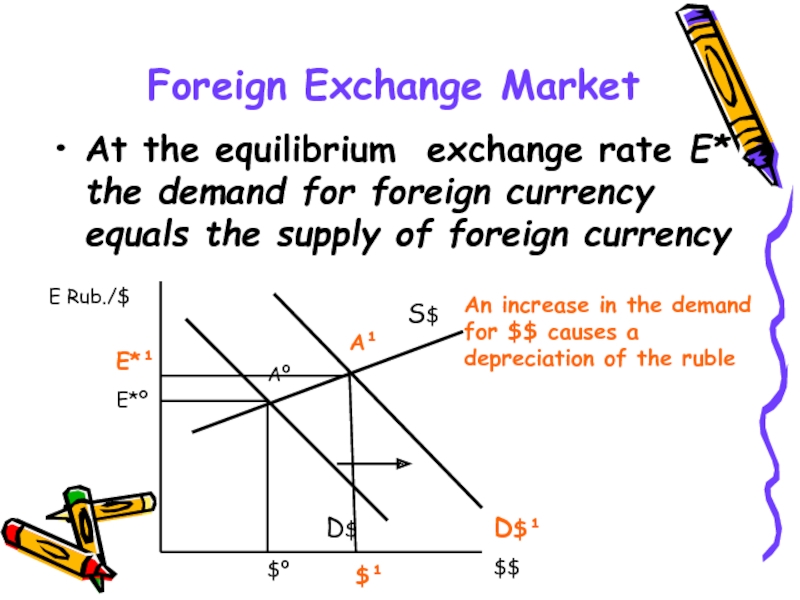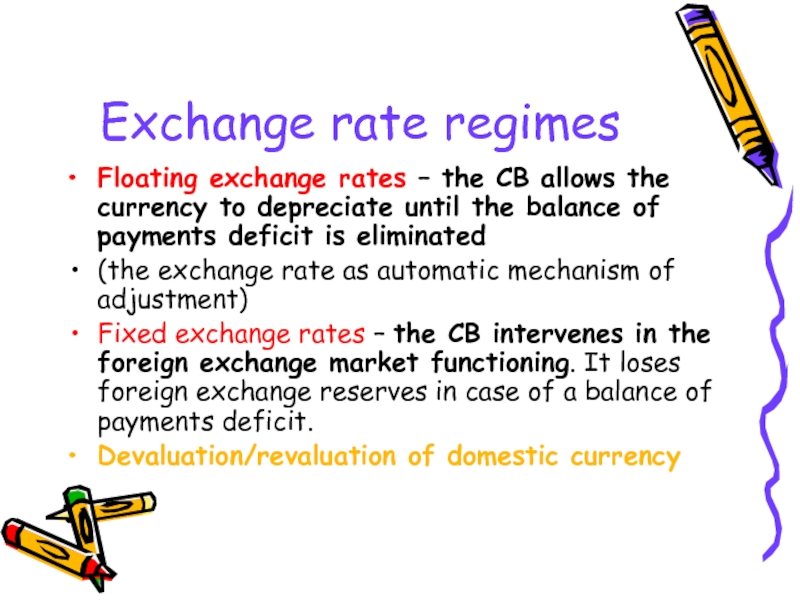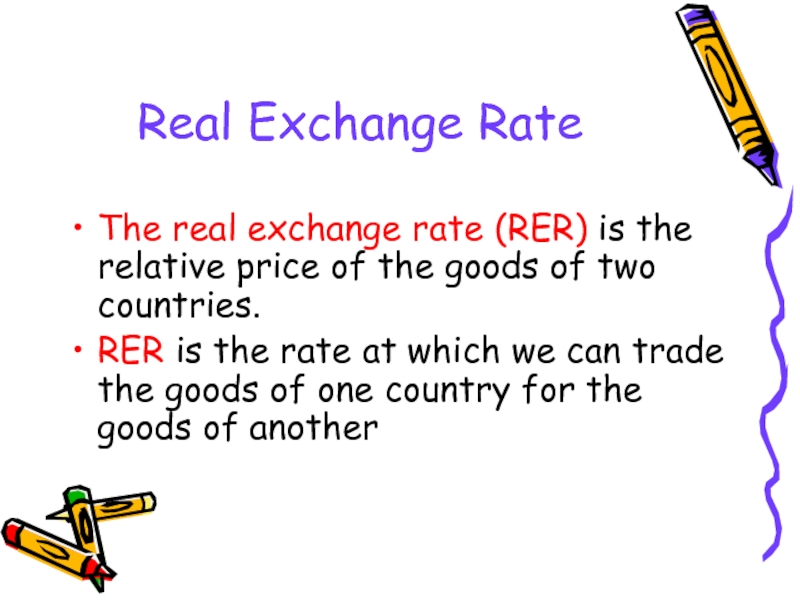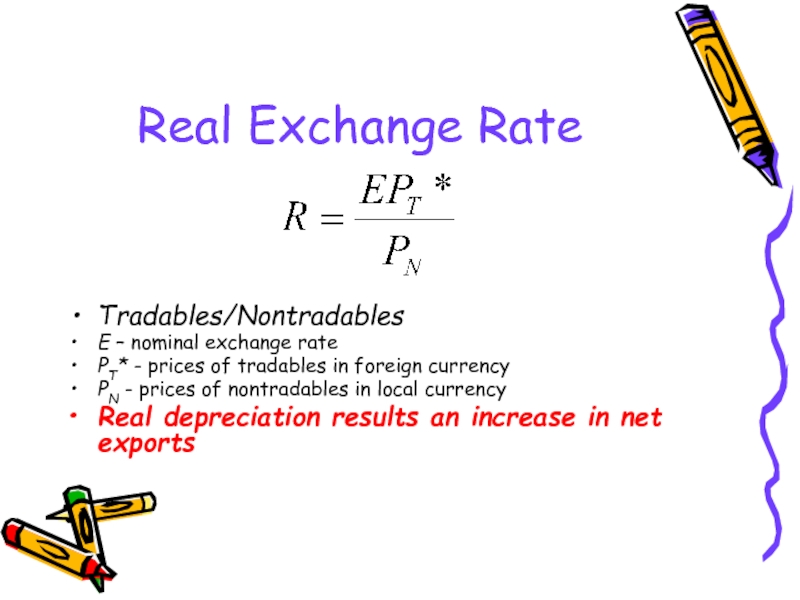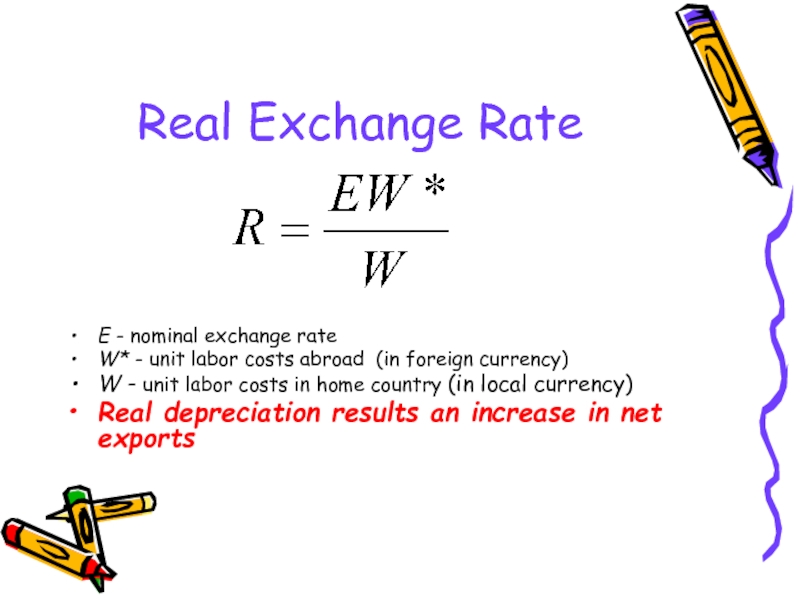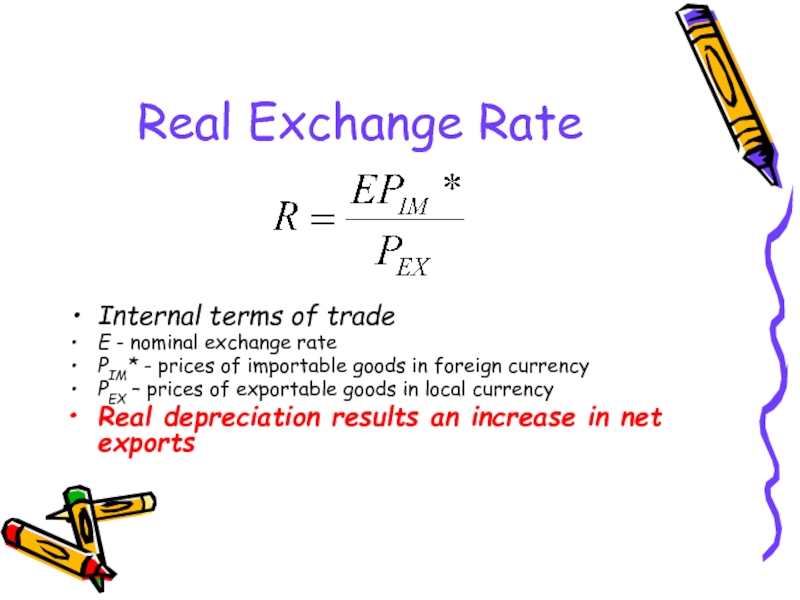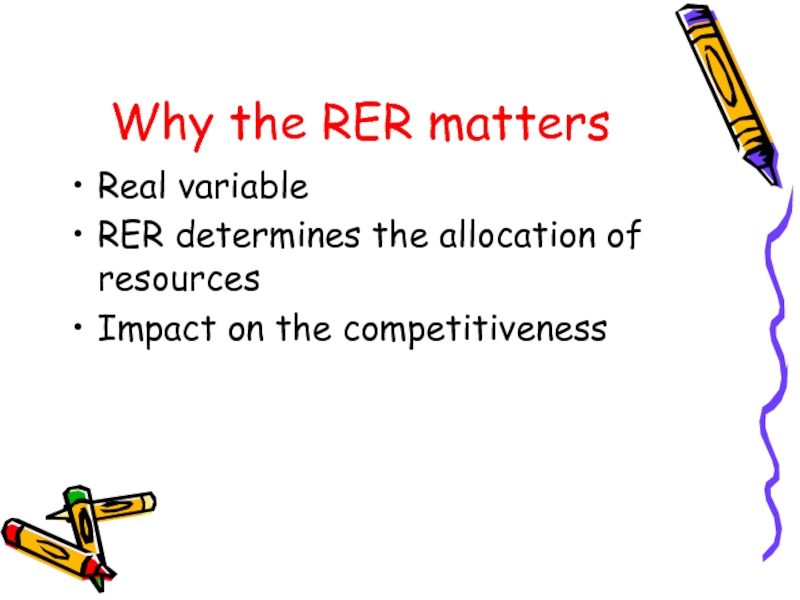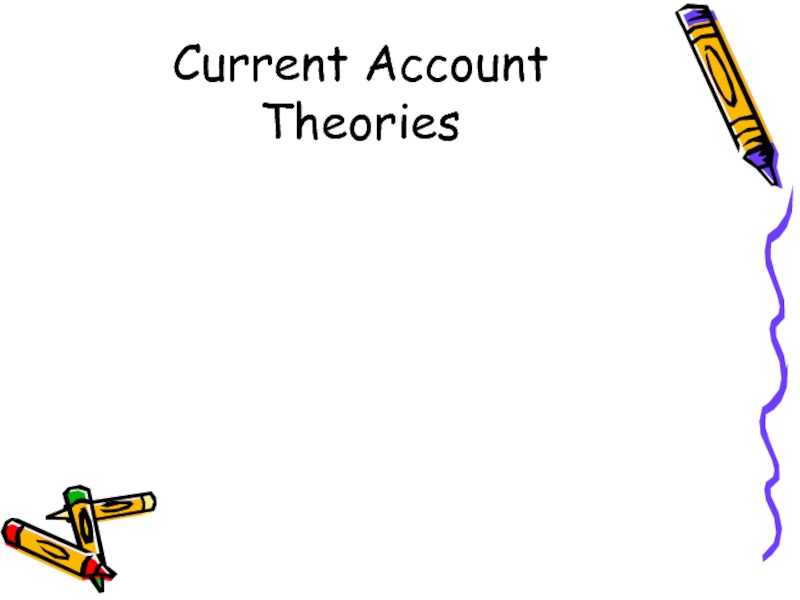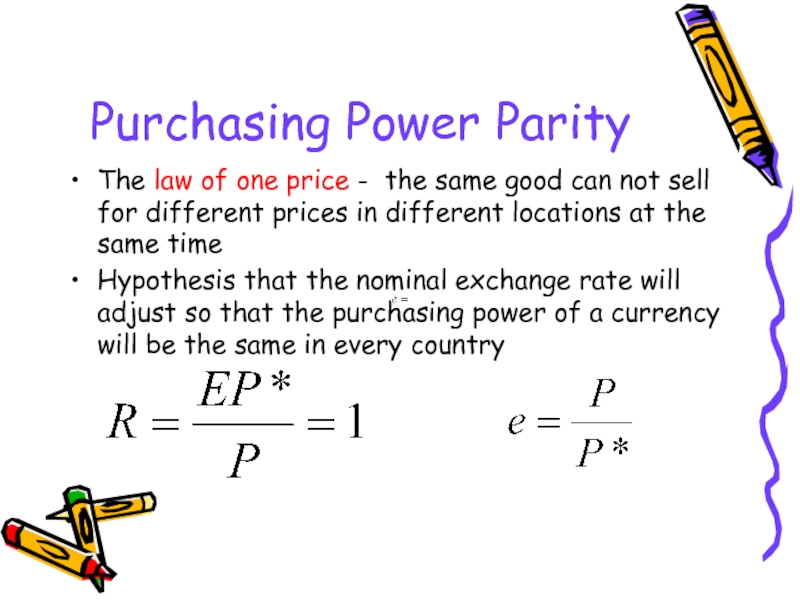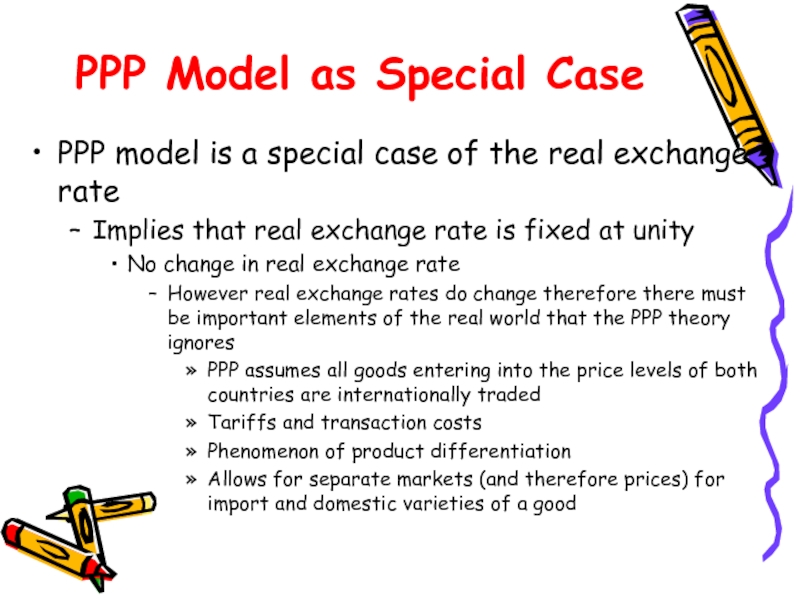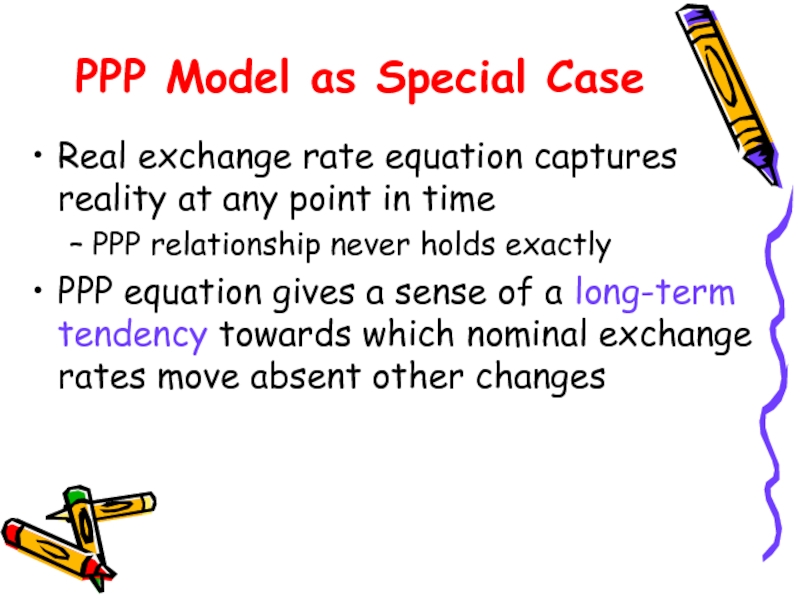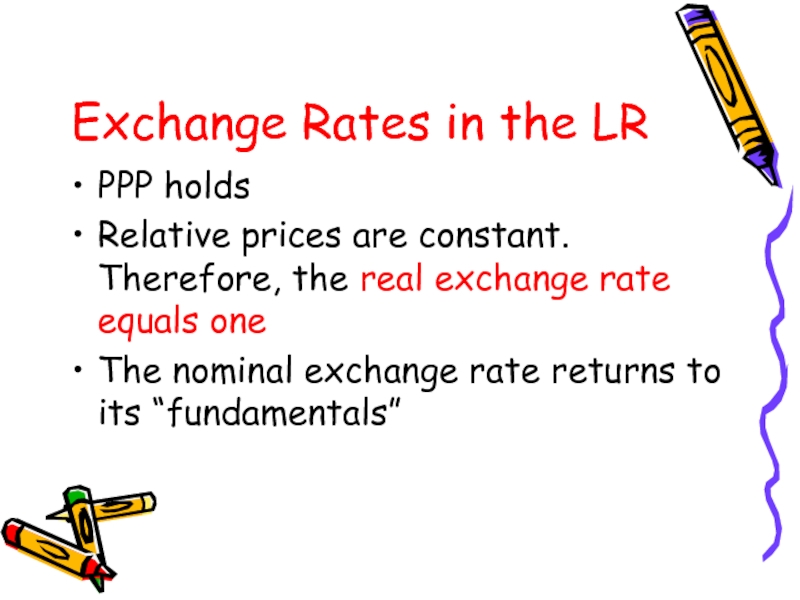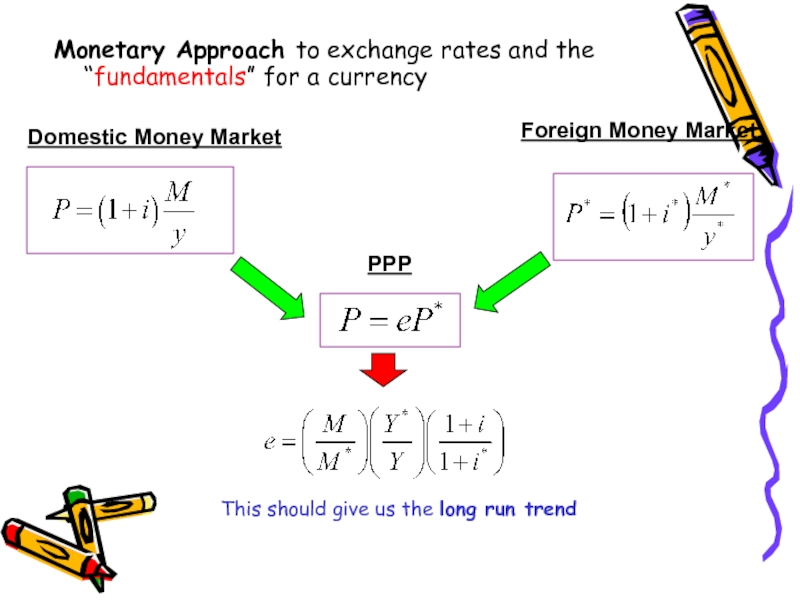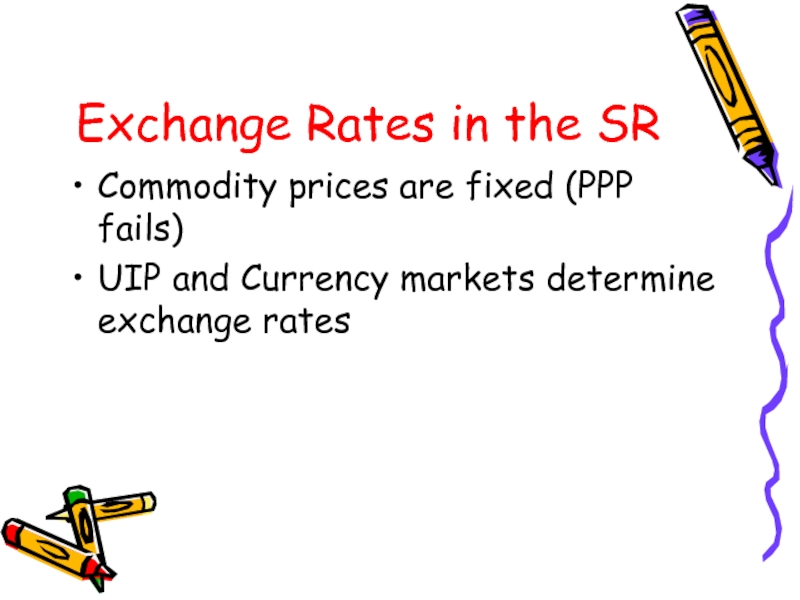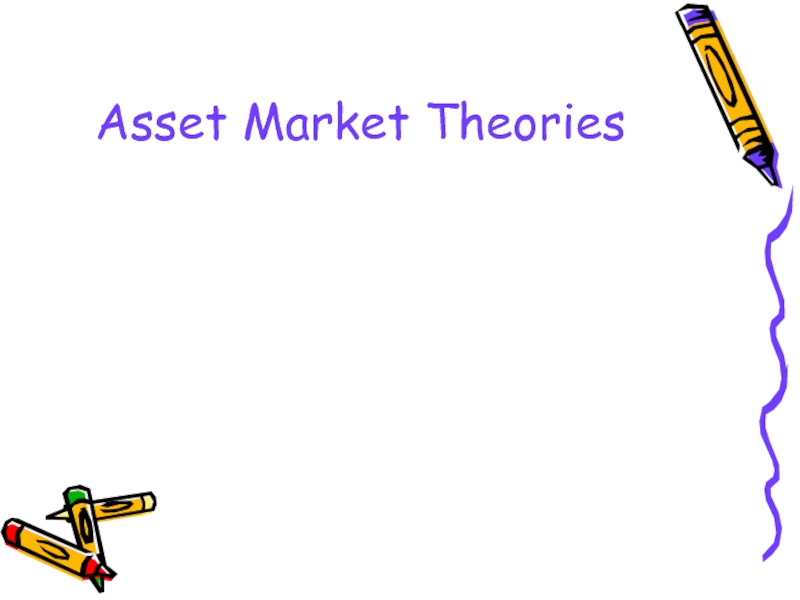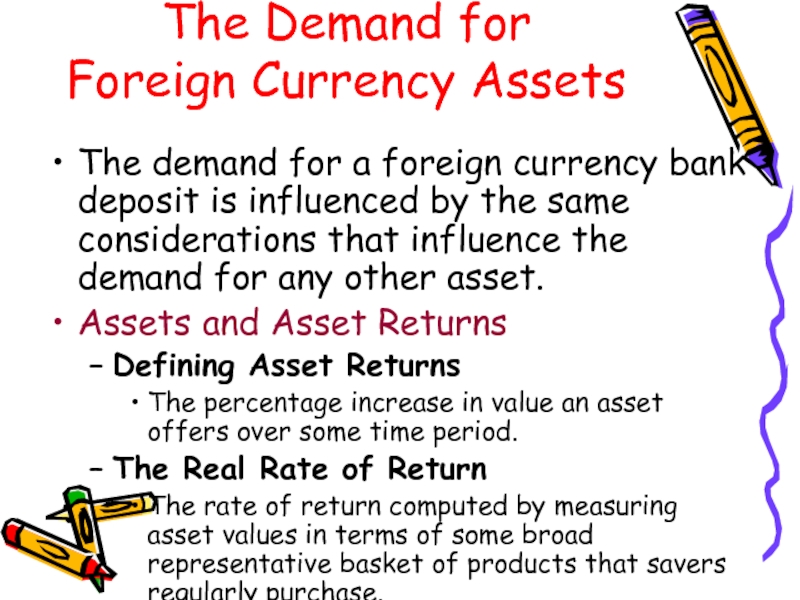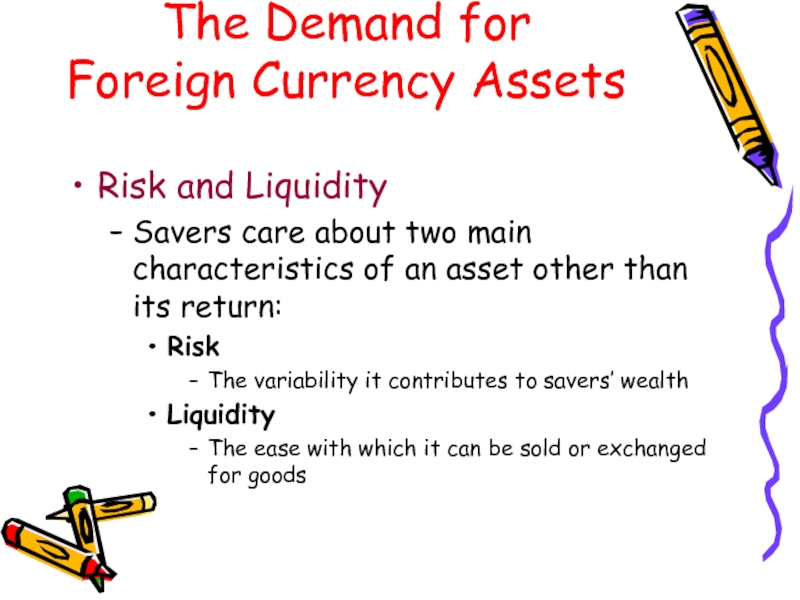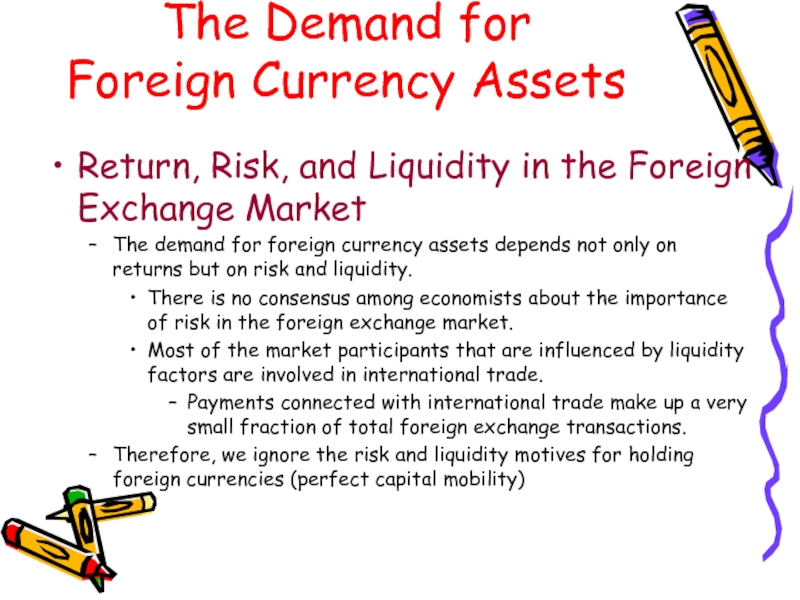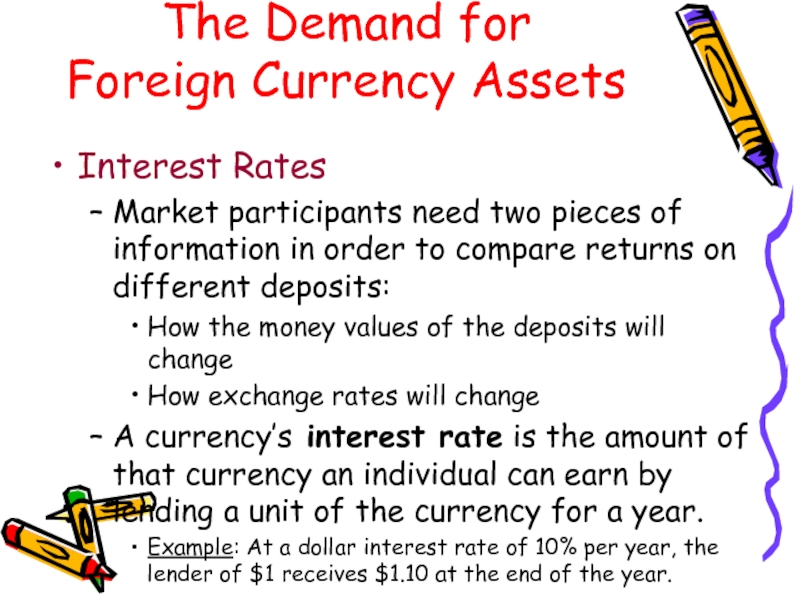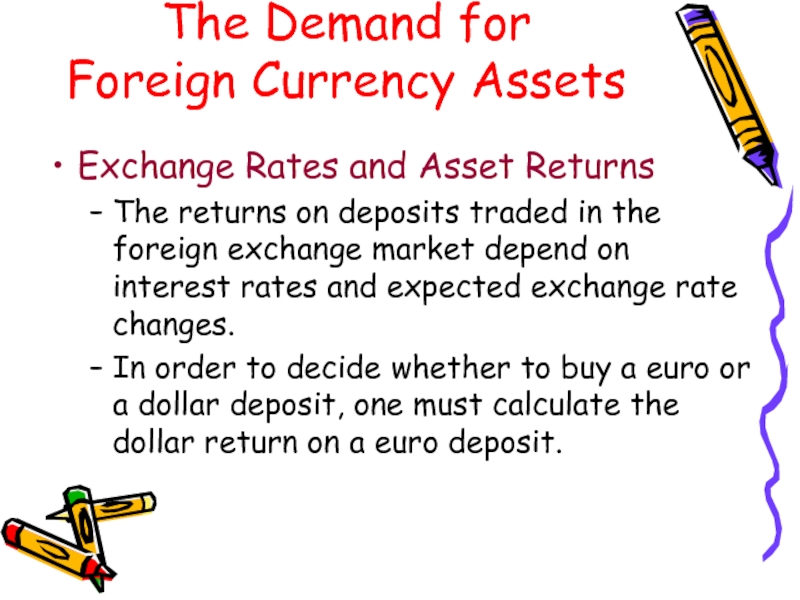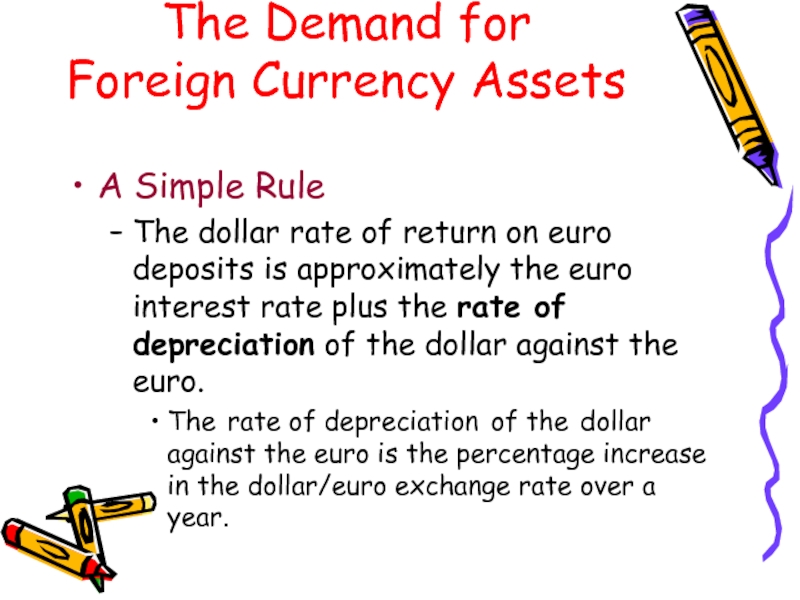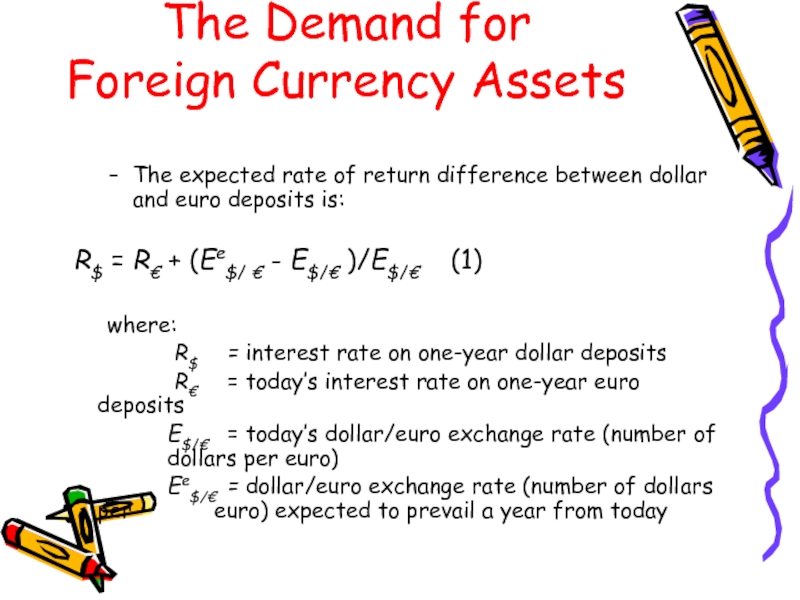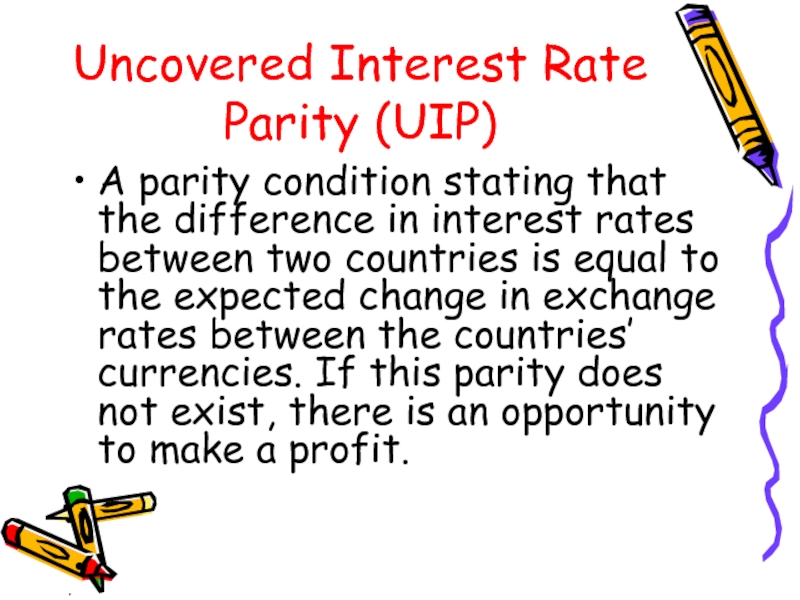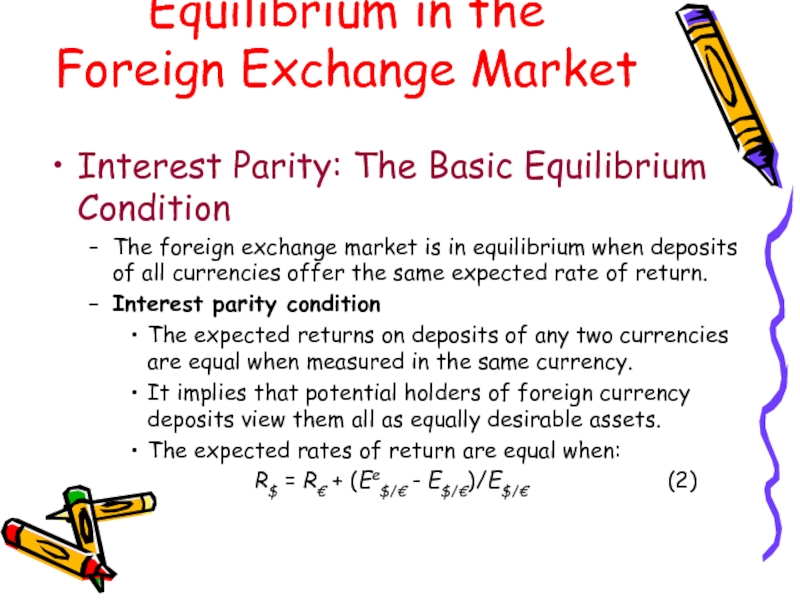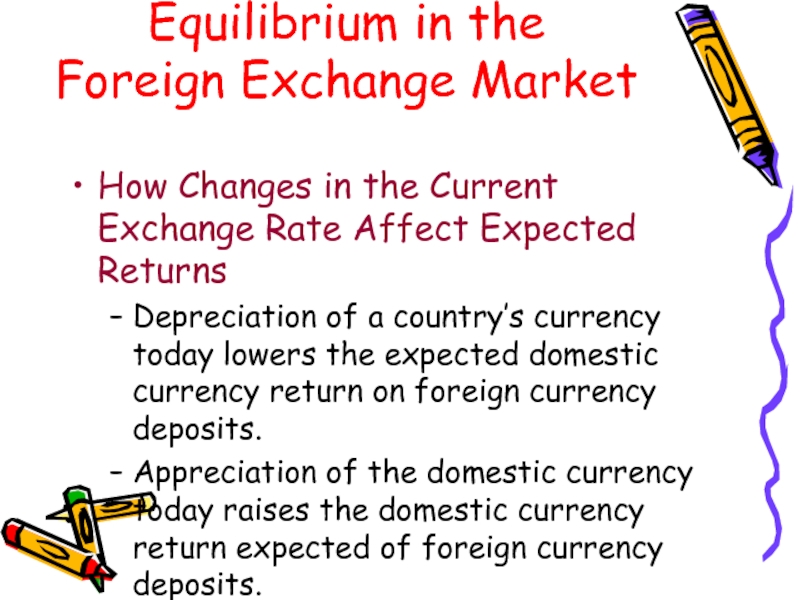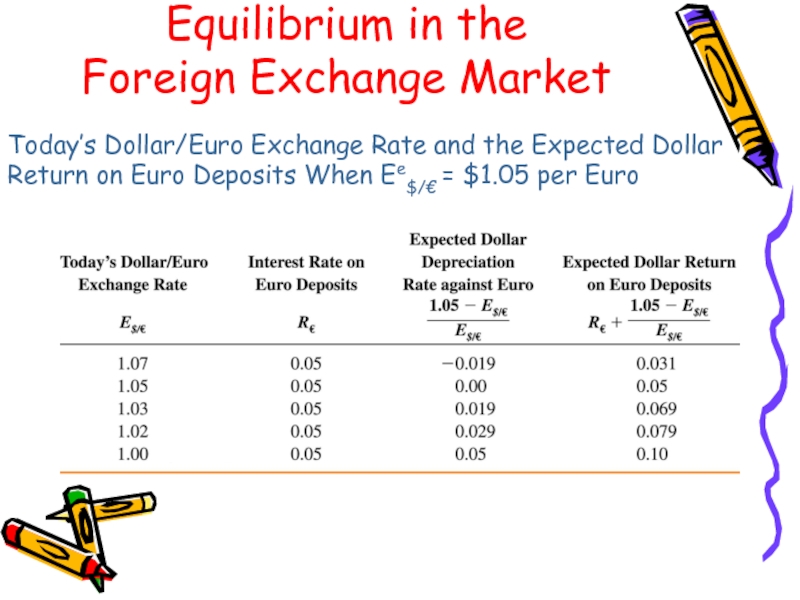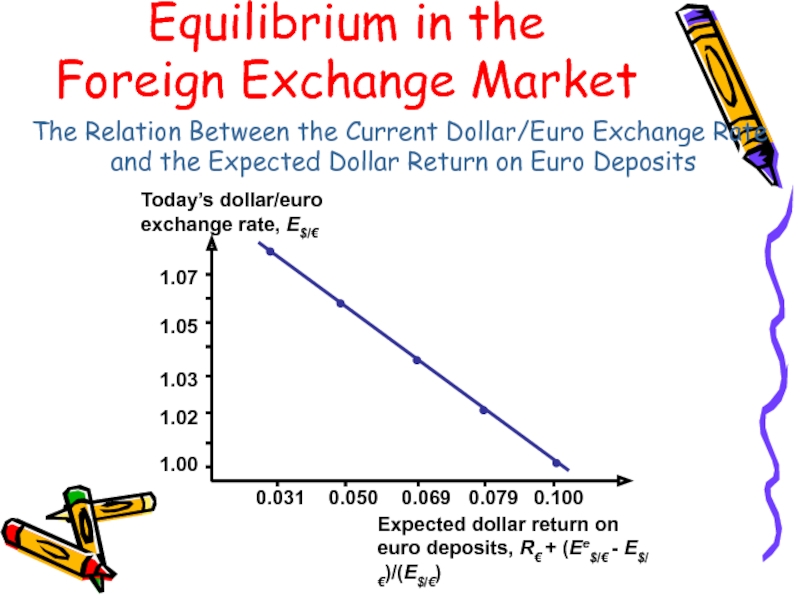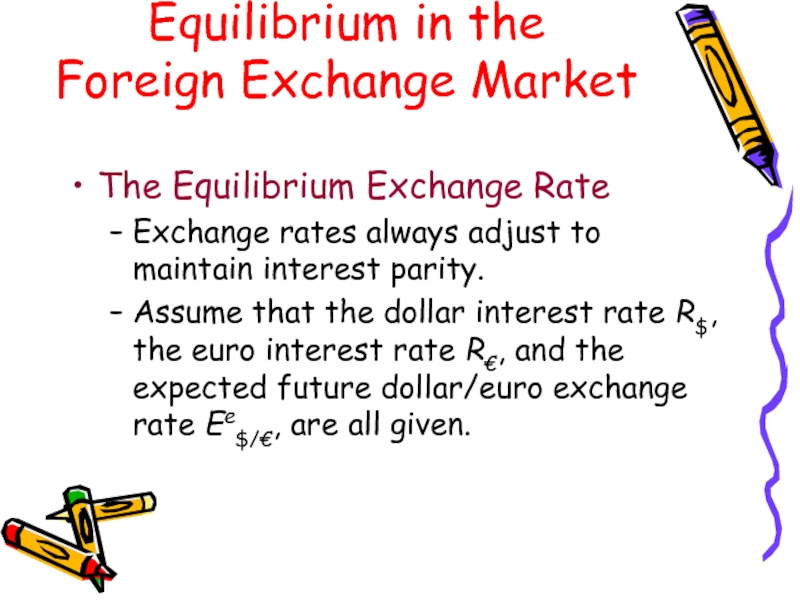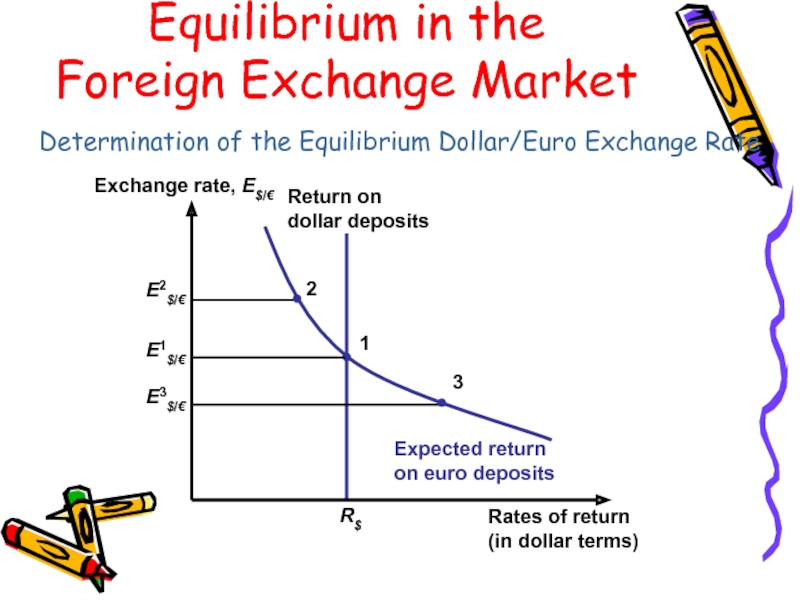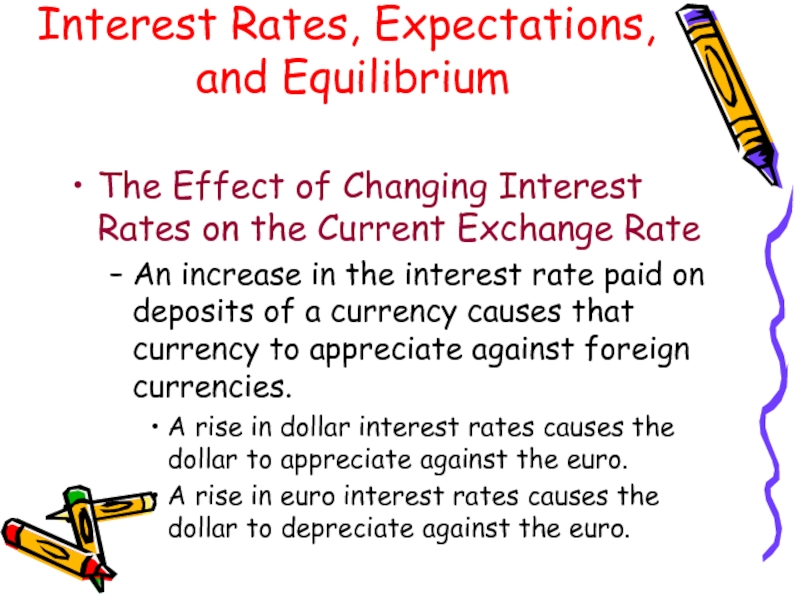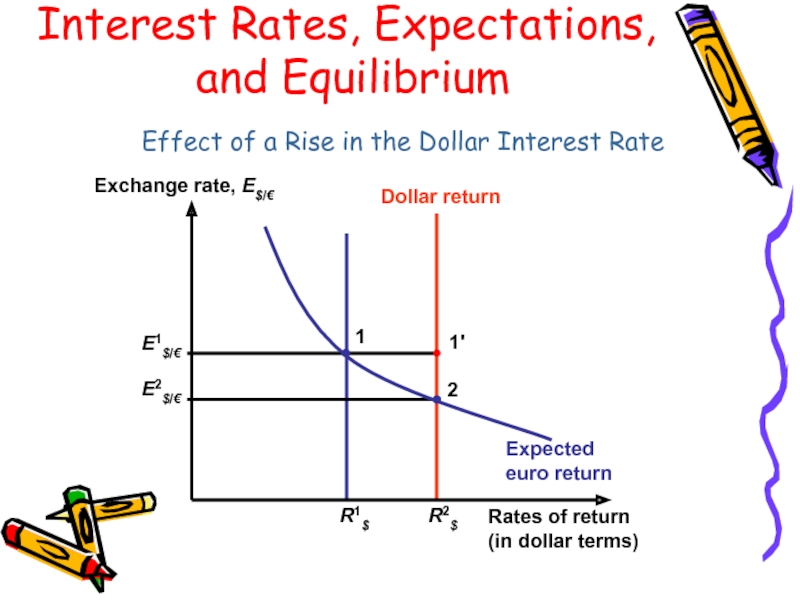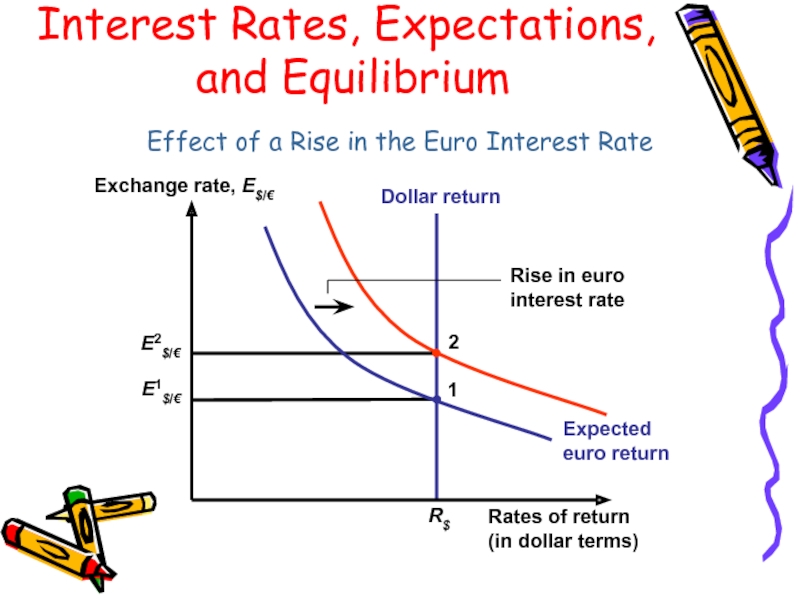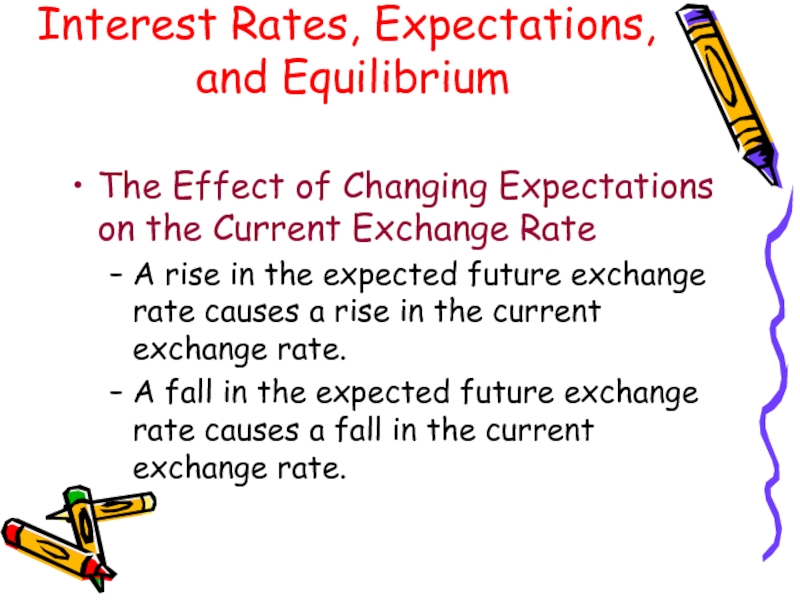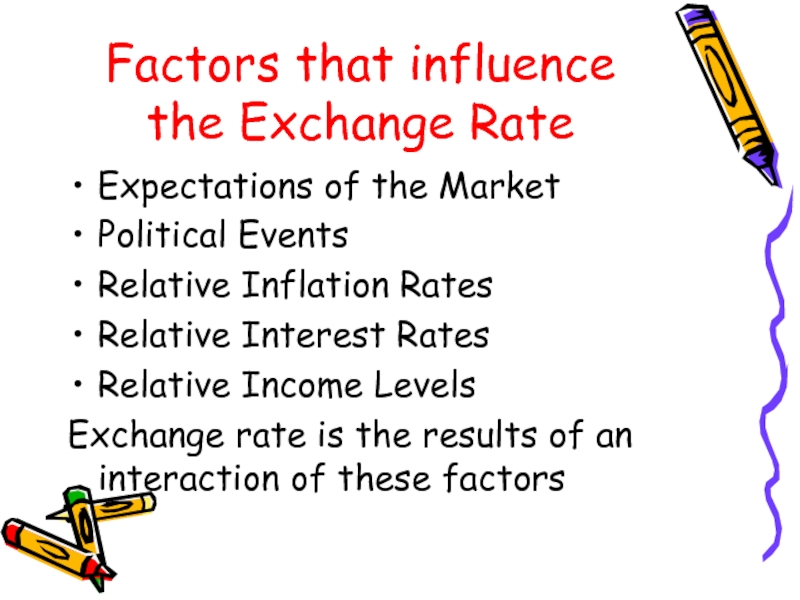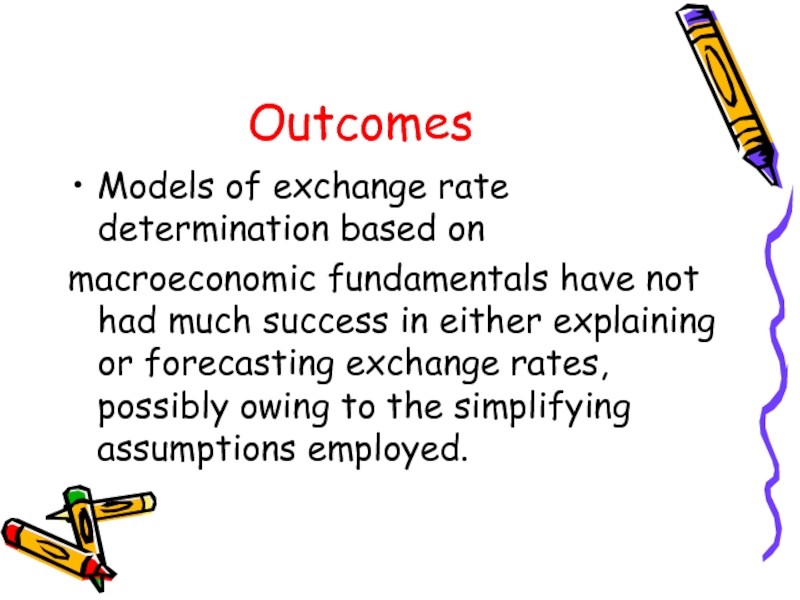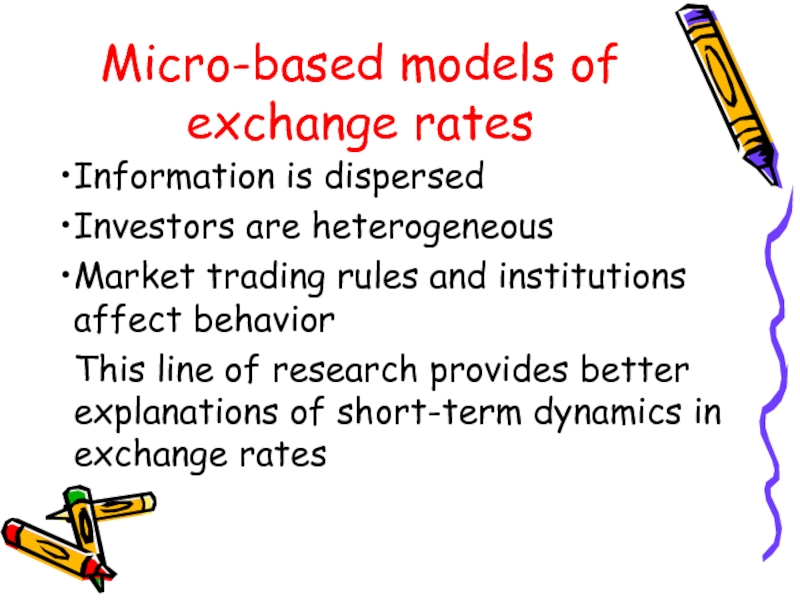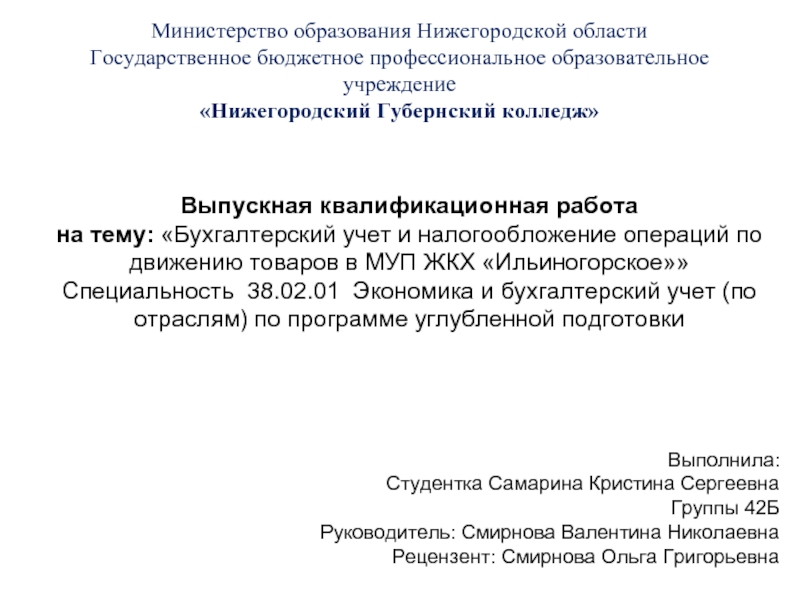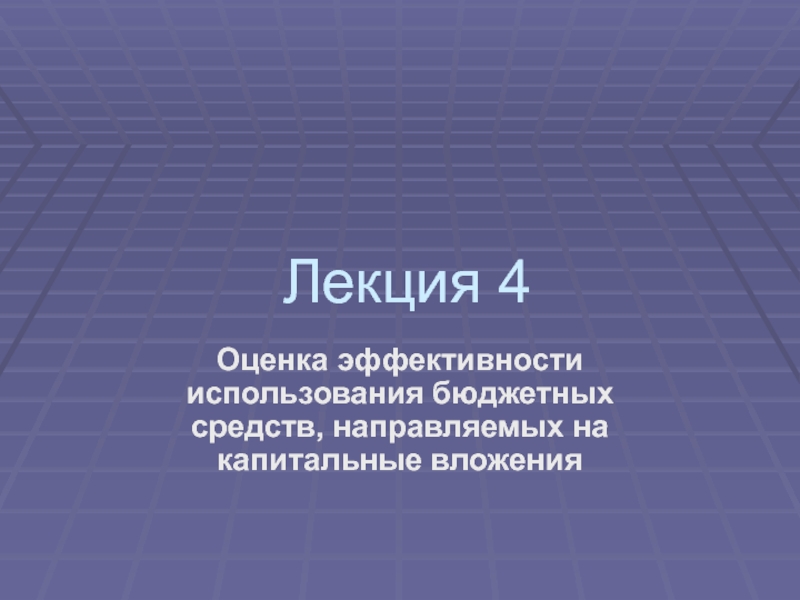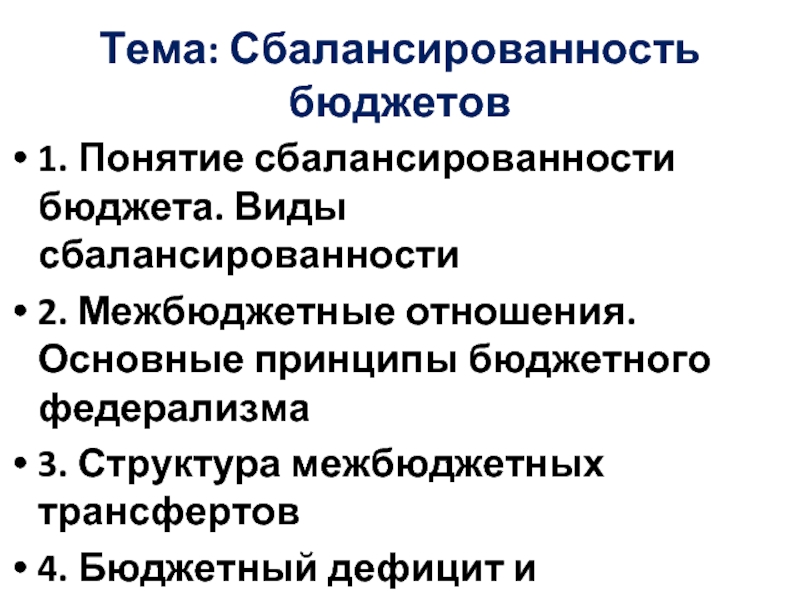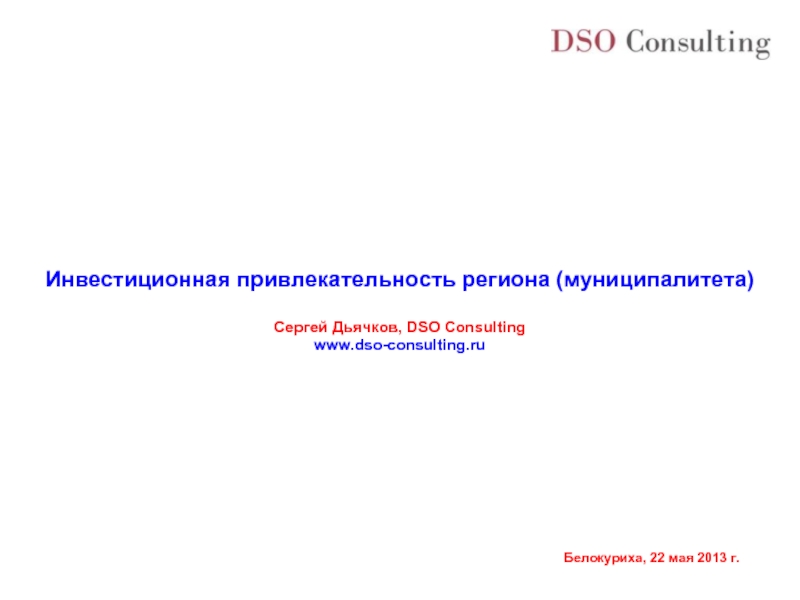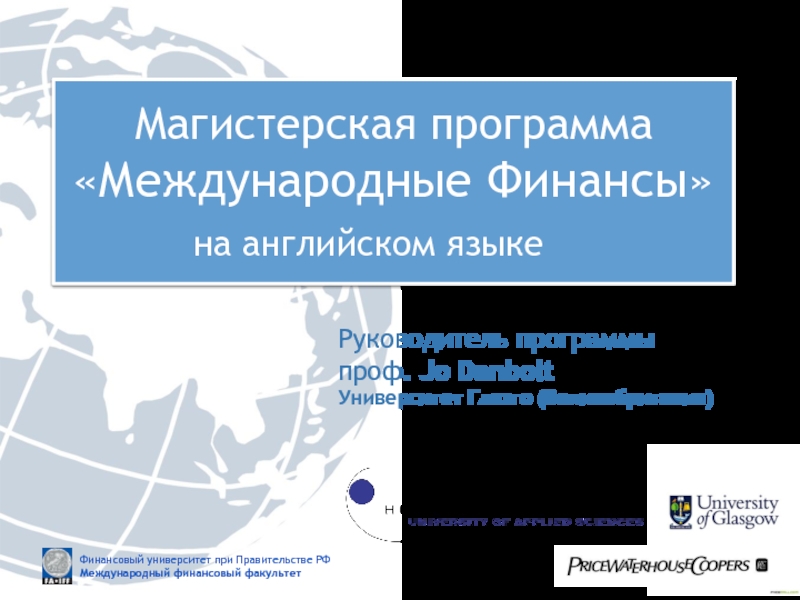- Главная
- Разное
- Дизайн
- Бизнес и предпринимательство
- Аналитика
- Образование
- Развлечения
- Красота и здоровье
- Финансы
- Государство
- Путешествия
- Спорт
- Недвижимость
- Армия
- Графика
- Культурология
- Еда и кулинария
- Лингвистика
- Английский язык
- Астрономия
- Алгебра
- Биология
- География
- Детские презентации
- Информатика
- История
- Литература
- Маркетинг
- Математика
- Медицина
- Менеджмент
- Музыка
- МХК
- Немецкий язык
- ОБЖ
- Обществознание
- Окружающий мир
- Педагогика
- Русский язык
- Технология
- Физика
- Философия
- Химия
- Шаблоны, картинки для презентаций
- Экология
- Экономика
- Юриспруденция
The theory of exchange rate determination презентация
Содержание
- 1. The theory of exchange rate determination
- 2. Outline Defining Exchange Rate Measuring Exchange Rate
- 3. Key words and concepts Exchange rate Depreciation
- 4. What does it mean EXCHANGE RATE? Nominal
- 5. Meaning of Nominal Exchange Rate Nominal exchange
- 6. Measuring Changes in Exchange Rates A decline
- 7. Appreciation/Depreciation Percentage change in value of
- 8. Exchange Rates and Relative Prices Import and
- 9. Nominal Exchange Rate Bilateral exchange rate is
- 10. The importance of exchange rate Price unification
- 11. The Foreign Exchange Market Exchange rates are
- 12. The foreign exchange market is the mechanism
- 13. Spot Rates and Forward Rates Spot exchange
- 14. Exchange Rate Equilibrium Forces of Demand and
- 15. Foreign Exchange Market At the equilibrium exchange
- 16. Exchange rate regimes Floating exchange rates –
- 17. Real Exchange Rate The real exchange
- 18. Real Exchange Rate
- 19. Real Exchange Rate
- 20. Real Exchange Rate
- 21. Real Exchange Rate
- 22. Why the RER matters Real variable RER
- 23. Current Account Theories
- 24. Purchasing Power Parity The law of one
- 25. PPP Model as Special Case PPP model
- 26. PPP Model as Special Case Real exchange
- 27. Exchange Rates in the LR PPP holds
- 28. Monetary Approach to exchange rates and the
- 29. Exchange Rates in the SR Commodity prices
- 30. Asset Market Theories
- 31. The demand for a foreign currency bank
- 32. Risk and Liquidity Savers care about two
- 33. Return, Risk, and Liquidity in the Foreign
- 34. Interest Rates Market participants need two pieces
- 35. Exchange Rates and Asset Returns The returns
- 36. A Simple Rule The dollar rate of
- 37. The expected rate of return difference between
- 38. Uncovered Interest Rate Parity (UIP) A parity
- 39. Equilibrium in the Foreign Exchange Market
- 40. How Changes in the Current Exchange Rate
- 41. Today’s Dollar/Euro Exchange Rate and the Expected
- 42. The Relation Between the Current Dollar/Euro Exchange
- 43. The Equilibrium Exchange Rate Exchange rates always
- 44. Determination of the Equilibrium Dollar/Euro Exchange Rate Equilibrium in the Foreign Exchange Market
- 45. The Effect of Changing Interest Rates on
- 46. Effect of a Rise in the
- 47. Effect of a Rise in the
- 48. The Effect of Changing Expectations on the
- 49. Factors that influence the Exchange Rate Expectations
- 50. Outcomes Models of exchange rate determination based
- 51. Micro-based models of exchange rates Information
Слайд 2Outline
Defining Exchange Rate
Measuring Exchange Rate Movements
Appreciation/Depreciation of a currency
Exchange Rate Equilibrium
Factors
The theory of exchange rate determination
Слайд 3Key words and concepts
Exchange rate
Depreciation
Appreciation
Balance of payments
Devaluation
Revaluation
Asset
Capital mobility
Volatility
Foreign exchange market
Determinants
Purchasing power parity (PPP)
Uncovered interest rate parity (UIP)
Слайд 4What does it mean EXCHANGE RATE?
Nominal exchange rate
Spot rate
Forward rate
Bilateral exchange
Effective exchange rate
Real exchange rate
Слайд 5Meaning of Nominal Exchange Rate
Nominal exchange rate is the relative price
An exchange rate can be quoted in two ways:
Direct
The price of the foreign currency in terms of domestic currency (the number of rubles needed to purchase one U.S. dollar)
Indirect
The price of domestic currency (pound) in terms of the foreign currency
Слайд 6Measuring Changes in Exchange Rates
A decline in a local currency’s value
If foreign currency A can buy you more units of local currency, currency A has appreciated and local currency depreciated
If foreign currency A can buy you less units of local currency, currency A has depreciated and local currency appreciated
Слайд 7Appreciation/Depreciation
Percentage change in value of Foreign Currency
New Value of one $
local Currency - Old value of one $ in terms of local currency
-------------------------------------------------- X 100
Old value of one $ in terms of local Currency
Depreciation of home country’s currency makes home goods cheaper for foreigners and foreign goods more expensive for domestic residents.
Appreciation of home country’s currency makes home goods more expensive for foreigners and foreign goods cheaper for domestic residents.
Слайд 8Exchange Rates and Relative Prices
Import and export demands are influenced by
Appreciation of a country’s currency:
Raises the relative price of its exports
Lowers the relative price of its imports
Depreciation of a country’s currency:
Lowers the relative price of its exports
Raises the relative price of its imports
Exchange Rates and
International Transactions
Слайд 9Nominal Exchange Rate
Bilateral exchange rate is the rate at which you
Nominal effective exchange rate is a measure of how the local currency does on average against all countries currencies
EE=(E$)α(E€)β(E¥)γ α+β+γ=1
Слайд 10The importance of exchange rate
Price unification of goods produced in different
Influence on the competitiveness of domestic goods in the foreign markets
Impact on exports and imports. If we know the exchange rate between two countries’ currencies, we can compute the price of one country’s exports in terms of the other country’s money.
Example: The dollar price of a £50 sweater with a dollar exchange rate of $1.50 per pound is (1.50 $/£) x (£50) = $75.
Influence on the relative price of assets and the level of capital mobility
Affect macroeconomic stability, the inflation rate and inflationary expectations
Слайд 11The Foreign Exchange Market
Exchange rates are determined in the foreign exchange
The market in which international currency trades take place
The Actors
The major participants in the foreign exchange market are:
Commercial banks
International corporations
Nonbank financial institutions
Central banks
Interbank trading
- Foreign currency trading among banks
It accounts for most of the activity in the foreign exchange market
Слайд 12The foreign exchange market is the mechanism by which participants:
transfer purchasing
obtain or provide credit for international trade transactions, and
minimize exposure to the risks of exchange rate changes
Functions of FX Market
Слайд 13Spot Rates and Forward Rates
Spot exchange rates
Apply to exchange currencies “on
Forward exchange rates
Apply to exchange currencies on some future date at a prenegotiated exchange rate
Forward and spot exchange rates, while not necessarily equal, do move closely together.
Exchange Rates and
International Transactions
Слайд 14Exchange Rate Equilibrium
Forces of Demand and Supply
Demand for foreign currency negatively
Supply of foreign currency positively related to the price of foreign currency
Forces of demand and supply together determine the exchange rate
Слайд 15Foreign Exchange Market
At the equilibrium exchange rate Е* , the demand
E Rub./$
$$
D$
S$
Aº
$º
E*º
An increase in the demand for $$ causes a depreciation of the ruble
D$¹
A¹
$¹
E*¹
Слайд 16Exchange rate regimes
Floating exchange rates – the CB allows the currency
(the exchange rate as automatic mechanism of adjustment)
Fixed exchange rates – the CB intervenes in the foreign exchange market functioning. It loses foreign exchange reserves in case of a balance of payments deficit.
Devaluation/revaluation of domestic currency
Слайд 17Real Exchange Rate
The real exchange rate (RER) is the relative price
RER is the rate at which we can trade the goods of one country for the goods of another
Слайд 18Real Exchange Rate
E – nominal exchange rate
Р* /P – ratio
Real effective exchange rate –
REER=(E$ P$*/P)α(E€P€/P)β(E¥P¥/P)γ α+β+γ=1
Real depreciation results an increase in net exports (NX)
Слайд 19Real Exchange Rate
Tradables/Nontradables
E – nominal exchange rate
РT* - prices of tradables
РN - prices of nontradables in local currency
Real depreciation results an increase in net exports
Слайд 20Real Exchange Rate
E - nominal exchange rate
W* - unit labor costs
W - unit labor costs in home country (in local currency)
Real depreciation results an increase in net exports
Слайд 21Real Exchange Rate
Internal terms of trade
E - nominal exchange rate
РIM* -
РEX – prices of exportable goods in local currency
Real depreciation results an increase in net exports
Слайд 22Why the RER matters
Real variable
RER determines the allocation of resources
Impact
Слайд 24Purchasing Power Parity
The law of one price - the same good
Hypothesis that the nominal exchange rate will adjust so that the purchasing power of a currency will be the same in every country
Слайд 25PPP Model as Special Case
PPP model is a special case of
Implies that real exchange rate is fixed at unity
No change in real exchange rate
However real exchange rates do change therefore there must be important elements of the real world that the PPP theory ignores
PPP assumes all goods entering into the price levels of both countries are internationally traded
Tariffs and transaction costs
Phenomenon of product differentiation
Allows for separate markets (and therefore prices) for import and domestic varieties of a good
Слайд 26PPP Model as Special Case
Real exchange rate equation captures reality at
PPP relationship never holds exactly
PPP equation gives a sense of a long-term tendency towards which nominal exchange rates move absent other changes
Слайд 27Exchange Rates in the LR
PPP holds
Relative prices are constant. Therefore,
The nominal exchange rate returns to its “fundamentals”
Слайд 28Monetary Approach to exchange rates and the “fundamentals” for a currency
Domestic
PPP
Foreign Money Market
This should give us the long run trend
Слайд 29Exchange Rates in the SR
Commodity prices are fixed (PPP fails)
UIP and
Слайд 31The demand for a foreign currency bank deposit is influenced by
Assets and Asset Returns
Defining Asset Returns
The percentage increase in value an asset offers over some time period.
The Real Rate of Return
The rate of return computed by measuring asset values in terms of some broad representative basket of products that savers regularly purchase.
The Demand for
Foreign Currency Assets
Слайд 32Risk and Liquidity
Savers care about two main characteristics of an asset
Risk
The variability it contributes to savers’ wealth
Liquidity
The ease with which it can be sold or exchanged for goods
The Demand for
Foreign Currency Assets
Слайд 33Return, Risk, and Liquidity in the Foreign Exchange Market
The demand for
There is no consensus among economists about the importance of risk in the foreign exchange market.
Most of the market participants that are influenced by liquidity factors are involved in international trade.
Payments connected with international trade make up a very small fraction of total foreign exchange transactions.
Therefore, we ignore the risk and liquidity motives for holding foreign currencies (perfect capital mobility)
The Demand for
Foreign Currency Assets
Слайд 34Interest Rates
Market participants need two pieces of information in order to
How the money values of the deposits will change
How exchange rates will change
A currency’s interest rate is the amount of that currency an individual can earn by lending a unit of the currency for a year.
Example: At a dollar interest rate of 10% per year, the lender of $1 receives $1.10 at the end of the year.
The Demand for
Foreign Currency Assets
Слайд 35Exchange Rates and Asset Returns
The returns on deposits traded in the
In order to decide whether to buy a euro or a dollar deposit, one must calculate the dollar return on a euro deposit.
The Demand for
Foreign Currency Assets
Слайд 36A Simple Rule
The dollar rate of return on euro deposits is
The rate of depreciation of the dollar against the euro is the percentage increase in the dollar/euro exchange rate over a year.
The Demand for
Foreign Currency Assets
Слайд 37The expected rate of return difference between dollar and euro deposits
R$ = R€ + (Ee$/ € - E$/€ )/E$/€ (1)
where:
R$ = interest rate on one-year dollar deposits
R€ = today’s interest rate on one-year euro deposits
E$/€ = today’s dollar/euro exchange rate (number of dollars per euro)
Ee$/€ = dollar/euro exchange rate (number of dollars per euro) expected to prevail a year from today
The Demand for
Foreign Currency Assets
Слайд 38Uncovered Interest Rate Parity (UIP)
A parity condition stating that the difference
"i1" represents the interest rate of country 1 "i2" represents the interest rate of country 2 "E(e)" represents the expected rate of change in the exchange rate
Read more: http://www.investopedia.com/terms/u/uncoveredinterestrateparity.asp#ixzz26CR0KSVZ
Слайд 39Equilibrium in the
Foreign Exchange Market
Interest Parity: The Basic Equilibrium Condition
The
Interest parity condition
The expected returns on deposits of any two currencies are equal when measured in the same currency.
It implies that potential holders of foreign currency deposits view them all as equally desirable assets.
The expected rates of return are equal when:
R$ = R€ + (Ee$/€ - E$/€)/E$/€ (2)
Слайд 40How Changes in the Current Exchange Rate Affect Expected Returns
Depreciation of
Appreciation of the domestic currency today raises the domestic currency return expected of foreign currency deposits.
Equilibrium in the
Foreign Exchange Market
Слайд 41Today’s Dollar/Euro Exchange Rate and the Expected Dollar
Equilibrium in the
Foreign Exchange Market
Слайд 42The Relation Between the Current Dollar/Euro Exchange Rate
and the Expected
Equilibrium in the
Foreign Exchange Market
Слайд 43The Equilibrium Exchange Rate
Exchange rates always adjust to maintain interest parity.
Assume
Equilibrium in the
Foreign Exchange Market
Слайд 44Determination of the Equilibrium Dollar/Euro Exchange Rate
Equilibrium in the
Foreign Exchange
Слайд 45The Effect of Changing Interest Rates on the Current Exchange Rate
An
A rise in dollar interest rates causes the dollar to appreciate against the euro.
A rise in euro interest rates causes the dollar to depreciate against the euro.
Interest Rates, Expectations,
and Equilibrium
Слайд 48The Effect of Changing Expectations on the Current Exchange Rate
A rise
A fall in the expected future exchange rate causes a fall in the current exchange rate.
Interest Rates, Expectations,
and Equilibrium
Слайд 49Factors that influence the Exchange Rate
Expectations of the Market
Political Events
Relative
Relative Interest Rates
Relative Income Levels
Exchange rate is the results of an interaction of these factors
Слайд 50Outcomes
Models of exchange rate determination based on
macroeconomic fundamentals have not
Слайд 51Micro-based models of exchange rates
Information is dispersed
Investors are heterogeneous
Market
This line of research provides better explanations of short-term dynamics in exchange rates
